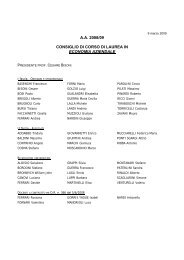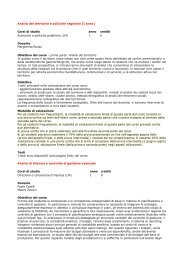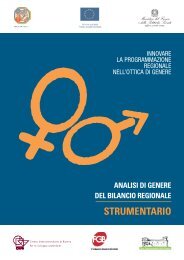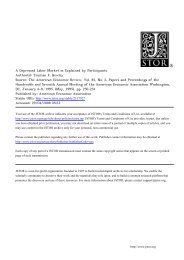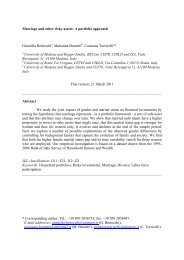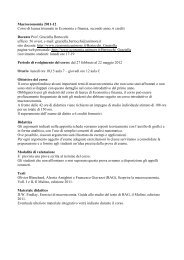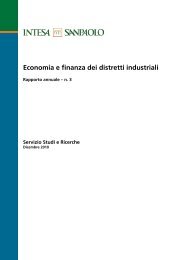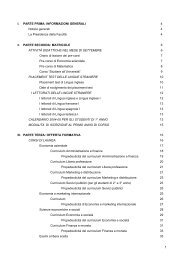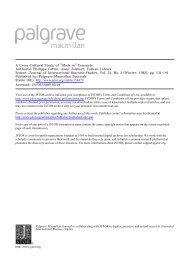Authors Study objectives Research m<strong>et</strong>hodology Major findingsResults of the study indicate that consumers’perceptions of new products from a given country arerelated to the image they hold for well-knownproducts for that country. Further, the extent oftransferability of beliefs is moderated by the degree ofperceived similarity b<strong>et</strong>ween the well-known and thenew product categories. It was <strong>al</strong>so found thattransference of beliefs to the new products wasgreater when the perceived similarity b<strong>et</strong>ween theData for this study were collected using a sampleidentified through systematic sampling, using th<strong>et</strong>elephone book of the m<strong>et</strong>ropolitan area closest to theuniversity where the pr<strong>et</strong>ests were conducted as thesampling frame. This m<strong>et</strong>hod was selected to ensurea high degree of correspondence b<strong>et</strong>ween thegeographic<strong>al</strong> sub-culture of the pr<strong>et</strong>est and mainstudy samples, as well as to obtain a sample thatincluded a wide vari<strong>et</strong>y of demographic profiles. Ofthe 800 questionnaires mailed, 198 were r<strong>et</strong>urnedTo investigate the transferability of country imagesfrom well-known products to new productcategories. Also, to examine wh<strong>et</strong>her, which, and towhat extent the various dimensions of country imagefor a well-known product category transfer toinfluence perceptions of new productsAgarw<strong>al</strong> and Sikri(1996)well-known product and the new product was higherThe results show that Canadian consumers are morefavorable toward products made in Mexico thanAmerican consumers. American consumers, on theother hand, are more nation<strong>al</strong>istic than theCanadians. While country-of-origin cues have a muchgreater impact of consumer reactions than other cues,including brand name, this impact is significantlyattenuated when other pieces of information arepresentThe study was based on a survey of 219 US and 175Canadian consumers. Their judgments of the qu<strong>al</strong>ityand purchase v<strong>al</strong>ue of automobiles, VCRs and shoeswere obtained in a multi-cue, ad-based s<strong>et</strong>tingAhmed <strong>et</strong> <strong>al</strong>. (1997) To manipulate country-of-origin information <strong>al</strong>ongtwo dimensions, namely country of design andcountry of assemblyThe results of the experiment indicated that th<strong>et</strong>est-r<strong>et</strong>est stability of attribute-based andentity-based multi-entity image ratings of the targ<strong>et</strong>country, Germany, as a producer of sm<strong>al</strong>lautomobiles, were lower than the test-r<strong>et</strong>est stabilityof single entity sc<strong>al</strong>ing image ratings of the targ<strong>et</strong>country when the rating context (another countrybeing rated) changed b<strong>et</strong>ween the test and r<strong>et</strong>est. Thestudy <strong>al</strong>so found that at least a portion of theinstability of multi-entity sc<strong>al</strong>ing found in previousstudies may be due to an inherent instabilityassociated with multi-entity sc<strong>al</strong>ing that is dependentof changes of context entitiesAn experiment involving survey respondents’ratings of sm<strong>al</strong>l automobiles produced in variouscountries was used. Automobiles produced inGermany were selected as the targ<strong>et</strong> entity. Thedependent variable in the experiment consisted ofthe stability of the German automobile ratings undervarious survey conditions created by manipulatingthe experiment<strong>al</strong> variables according to a 5 £ 2full-factori<strong>al</strong> experiment<strong>al</strong> design. Compl<strong>et</strong>e s<strong>et</strong>s ofresponses were received from 537 respondentsTo examine, via a controlled experiment, the issue ofmeasurement context effects in multi-entity sc<strong>al</strong>ingof country imagesAgarw<strong>al</strong> <strong>et</strong> <strong>al</strong>.(1997)The findings reve<strong>al</strong>ed that upper-income Mexicansprefer foreign products, but this was mediated by age,education, and household size. No significantdifferences in m<strong>al</strong>inchismo were found for gender,marit<strong>al</strong> status, employment status, and for two of thelifestyle questionsPerson<strong>al</strong> interviews among Mexican consumers (200in Mexico City, 100 in Monterey, and 100 inGuad<strong>al</strong>ajara) representing upper-middle classsocio-economic groups were conducted and, as partof the larger study, the brief ten-item CETSCALEwas added to ev<strong>al</strong>uate the gener<strong>al</strong> attitude towardimported goodsTo d<strong>et</strong>ermine the degree to which upper-classMexicans have a positive attitude towardforeign-made products, using the CETSCALE toascertain socio-demographic characteristicsassociated with m<strong>al</strong>inchismo and to ev<strong>al</strong>uate ifm<strong>al</strong>inchismo influences Mexican consumersBailey and Pineres(1997)(continued)US versusChinese goods789Table I.
<strong>EJM</strong>41,7/8790Table I.Authors Study objectives Research m<strong>et</strong>hodology Major findingsResults from both countries support theCETSCALE’s unidimension<strong>al</strong>ity, reliability,discriminant and nomologic<strong>al</strong> v<strong>al</strong>idity. US samplehad a significantly greater mean v<strong>al</strong>ue on the sc<strong>al</strong><strong>et</strong>han the Russian sample. The Russians hadsignificantly more favorable beliefs and attitudestoward foreign products than the USAA questionnaire survey administered among 204students, of which 144 from a major, Midwestern USuniversity and 60 from two major universities in theRussian FederationTo establish the dimension<strong>al</strong>ity, reliability andv<strong>al</strong>idity of the CETSCALE and its related measuresin both Russia and the USA and to examine the meandifferences b<strong>et</strong>ween the two countriesDurvasula <strong>et</strong> <strong>al</strong>.(1997)The results invoked country images for both thecountry-of-brand origin and the country-ofmanufacture,and found that both cues are important inconsumer ev<strong>al</strong>uations of product qu<strong>al</strong>ity, productv<strong>al</strong>ue, and willingness-to-buy. The relative s<strong>al</strong>ience ofthe country-of-manufacture and country-of-brandorigin cues were found to vary according to wh<strong>et</strong>herthe product is a “non-technic<strong>al</strong> fashion product” (e.g.sneakers and jeans) or it is a “low-technology, technic<strong>al</strong>product” (e.g. stereos and watches)The study used a 2 £ 2 £ 3 subjects design withprice (high and low), two country-of-origin brandlevels (USA and an appropriate European country)and three country-of-manufacture levels (USA, anNIC, and a developing country). A within-subjectdesign was used not only to assess how subjectsev<strong>al</strong>uated differences in price, brand origins andmanufacture information, but <strong>al</strong>so to excludeextraneous b<strong>et</strong>ween-subject differences that mayconfound the results. Subjects were 275undergraduate business students of a largeNortheastern US cityTo study: (a) the impact of price, country-of-brandorigin, and country-of-manufacture cues onconsumer ev<strong>al</strong>uations of qu<strong>al</strong>ity and v<strong>al</strong>ue; (b) thedegree to which v<strong>al</strong>ue perceptions follow qu<strong>al</strong>ityconsiderations rather than mere price, and (c) thewillingness-to-buy products that are manufacturedin the NICs and developing countriesIyer and K<strong>al</strong>ita(1997)Results offered preliminary evidence that Garvin’staxonomy has m<strong>et</strong> a number of key v<strong>al</strong>idity criteriaand demonstrated its direct relevance to COOresearch. Results <strong>al</strong>so confirmed that the adoption ofGarvin’s taxonomy in the COO research can facilitateA 4 (COO) £ 2 (brand) b<strong>et</strong>ween-subject experiment<strong>al</strong>design, with each respondent answering questionscorresponding to only one of eight experiment<strong>al</strong>situations and rating the qu<strong>al</strong>ity of dress shirts basedon Garvin’s eight qu<strong>al</strong>ity dimensions. The fin<strong>al</strong>sample comprised 776 consumersLi and Dant (1997) To adopt Garvin’s (1984) taxonomy inconceptu<strong>al</strong>izing and operation<strong>al</strong>izing product qu<strong>al</strong>itydimensions for COO researchtheory-building or gener<strong>al</strong>izations across studiesThe results reve<strong>al</strong> that product ev<strong>al</strong>uations werehighest for highly-developed countries, followed bynewly-industri<strong>al</strong>ized, newly-mark<strong>et</strong>izing, anddeveloping-country groups. Further, theproduct-category and country-of-origin effectsinteracted, showing that, depending on the countrygroup, different product categories received more,equ<strong>al</strong>, or less favorable ev<strong>al</strong>uations compared withother product categoriesThe sample comprised 63 juniors and seniorsenrolled in the business school of an East Coast USuniversity. There were 42 fem<strong>al</strong>es and 21 m<strong>al</strong>es inthe sample. The subjects were asked to ev<strong>al</strong>uate 18products based on their knowledge, assuming thatthe products described were made in each of 21 givencountriesManrai <strong>et</strong> <strong>al</strong>. (1998) To examine the effects of country of origin andproduct category on product ev<strong>al</strong>uations for 21countries and 18 products. Also, to assess if differentproduct categories are ev<strong>al</strong>uated differentlydepending on in which group of countries they aresourced(continued)
- Page 1: The current issue and full text arc
- Page 7: EJM41,7/8792Table I.Authors Study o
- Page 10 and 11: in overseas markets, and the adjust
- Page 12: 2002a, b). Products made in countri
- Page 15 and 16: EJM41,7/8800may also create positiv
- Page 17 and 18: EJM41,7/8802Sample profileIn terms
- Page 19 and 20: EJM41,7/8804Table III.Literature so
- Page 21 and 22: EJM41,7/8806Table IV.Confirmatory f
- Page 23 and 24: EJM41,7/8808Table VI.A comparison o
- Page 25 and 26: EJM41,7/8810Table VII.A multi-level
- Page 27 and 28: EJM41,7/8812situation, it is not su
- Page 29 and 30: EJM41,7/8814based on their previous
- Page 31 and 32: EJM41,7/8816Bannister, J.P. and Sau
- Page 33 and 34: EJM41,7/8818Kaynak, E. and Kara, A.
- Page 35: EJM41,7/8820Tse, D.K. and Gorn, G.J




